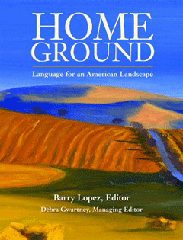The Language of Landscape
Air Date: Week of October 31, 2008

(Courtesy of Trinity University Press)
Living on Earth continues its series exploring features of the American landscape. It’s based on the book “Home Ground: Language for an American Landscape,” edited by Barry Lopez and Debra Gwartney. This week, John Daniel explains the term “stratovolcano.”
Transcript
Among the earth’s geothermal sweet spots are areas where volcanic activity is high. They’re not places people ordinarily live - but awe-inspiring features of our planet - also featured in the book, “Home Ground, Language for an American Landscape.” It’s a compilation of geological terms edited by Barry Lopez and Debra Gwartney, and an occasional series on Living on Earth. Today, John Daniel’s definition of “Stratovolcano.”
DANIEL: Stratovolcano. Stratovolcanoes, also called composite or cone volcanoes, are known for their stature as mountains and for their variety of utterance. Venting at times pyroclastic – “fire-broken” – particulates, as Mount St. Helens did in 1980, and at other times exuding lava, a stratovolcano develops a layered composition as it grows. The steeply bedded ash and cinders of its pyroclastic explosions tend to give it a conical form, while its gentler expressions of lava provide structural stability. All the major Pacific Rim volcanoes are stratovolcanoes. By present measurements, it takes anywhere from roughly 20,000 years (St. Helens) to more than half a million years (Hood and Rainier) to build a stratovolcano of respectable size. Some erupt so exuberantly that they self-destruct. Mount Mazama, a 12,000-foot peak in the southern Oregon Cascades composed of several overlapping volcanoes, emptied its magma chamber and blew off its upper four thousand feet - 12 cubic miles of rock - in a single day some 6,800 years ago, collapsing into a caldera we call Crater Lake.
GELLERMAN: John Daniel lives and writes in the hills just outside of Eugene, Oregon. His definition of stratovolcano comes from the book "Home Ground: Language for an American Landscape," edited by Barry Lopez and Debra Gwartney.

(Courtesy of Trinity University Press)
GELLERMAN: You can hear Living on Earth anytime on our website, or get a download for your MP3 player. The address is loe.org. That's L-O-E dot O-R-G. There you’ll also find pictures and more information about our stories and show. We’d particularly like to hear from you now – because next time on our program, we’ll be featuring what you think the new president’s environmental priorities should be, and what the new administration should do about energy in its first 100 days.
Our email address is: comments@loe.org – that’s comments at l-o-e dot o-r-g - or you can call us: 1-800-218-99-88, or 1-800-218-9-9-8-8. Your ideas - next time on Living on Earth.
Coming up: how the chain gang can earn a tax credit. Keep listening to Living on Earth.
ANNOUNCER: Support for the Environmental Health Desk at Living on Earth comes from the Cedar Tree Foundation. Support also comes from the Richard and Rhoda Goldman fund for coverage of population and the environment. And from Gilman Ordway for coverage of conservation and environmental change. This is Living on Earth on PRI, Public Radio International.
Living on Earth wants to hear from you!
Living on Earth
62 Calef Highway, Suite 212
Lee, NH 03861
Telephone: 617-287-4121
E-mail: comments@loe.org
Newsletter [Click here]
Donate to Living on Earth!
Living on Earth is an independent media program and relies entirely on contributions from listeners and institutions supporting public service. Please donate now to preserve an independent environmental voice.
NewsletterLiving on Earth offers a weekly delivery of the show's rundown to your mailbox. Sign up for our newsletter today!
 Sailors For The Sea: Be the change you want to sea.
Sailors For The Sea: Be the change you want to sea.
 The Grantham Foundation for the Protection of the Environment: Committed to protecting and improving the health of the global environment.
The Grantham Foundation for the Protection of the Environment: Committed to protecting and improving the health of the global environment.
 Contribute to Living on Earth and receive, as our gift to you, an archival print of one of Mark Seth Lender's extraordinary wildlife photographs. Follow the link to see Mark's current collection of photographs.
Contribute to Living on Earth and receive, as our gift to you, an archival print of one of Mark Seth Lender's extraordinary wildlife photographs. Follow the link to see Mark's current collection of photographs.
 Buy a signed copy of Mark Seth Lender's book Smeagull the Seagull & support Living on Earth
Buy a signed copy of Mark Seth Lender's book Smeagull the Seagull & support Living on Earth

